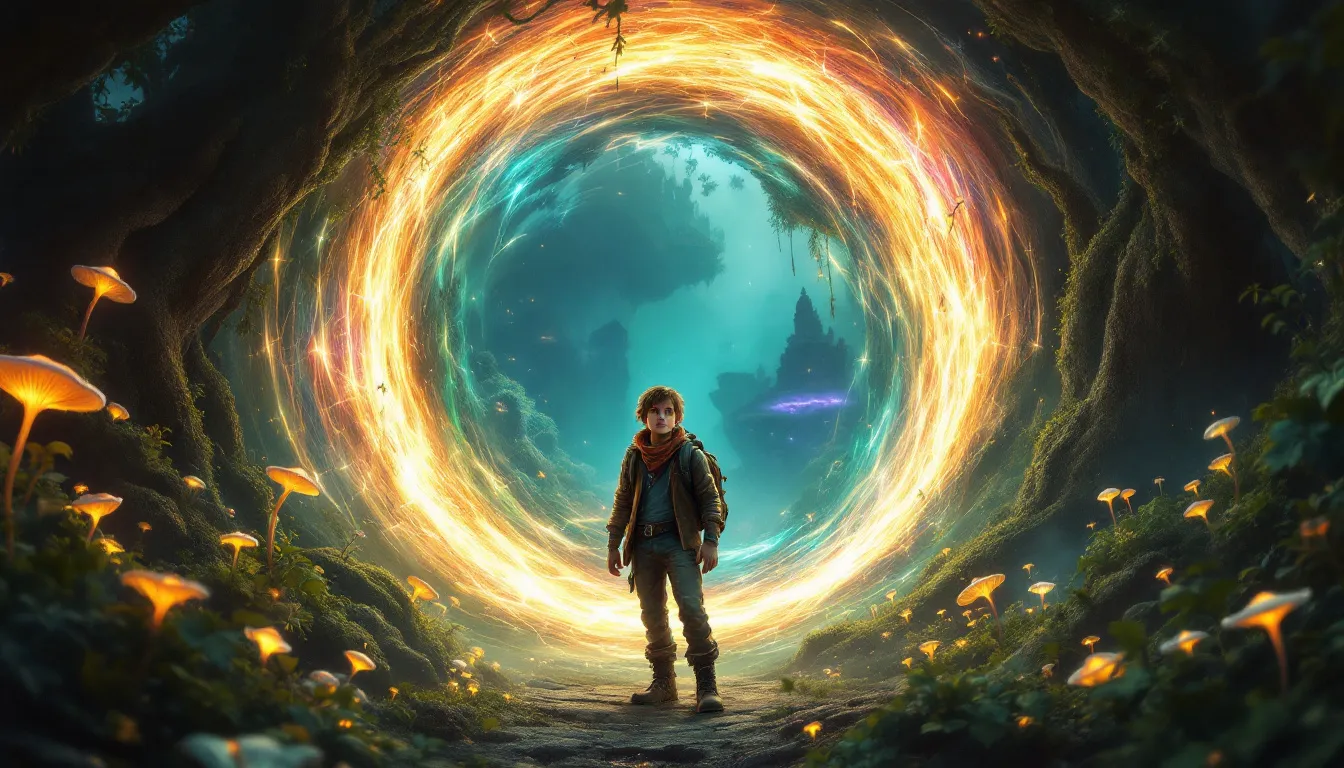Table of Contents
Introduction to Hidden Dimensions in Fantasy
Imagine opening a book and being whisked away to a world where the laws of physics are tossed aside, and each page reveals a new layer of reality. Hidden dimensions in fantasy literature are these whimsical, mysterious realms that stretch our imagination beyond the familiar. Historically, they have evolved from ancient myths to modern tales, reflecting our enduring curiosity about the unknown. Delving into how these dimensions operate is like uncovering the gears of a fantastical clockwork universe, where each mechanism invites us to question the very nature of reality.
The Mechanics of Hidden Dimensions
In many beloved fantasy stories, ordinary settings such as a wardrobe, a train platform, or a dusty book become gateways to worlds beyond imagination. These portals enchant us with their ability to transform the mundane into the extraordinary. I remember reading “The Lion, the Witch and the Wardrobe” as a child and obsessively checking every closet in hopes of finding my own Narnia. I never encountered a faun or a talking beaver, but the thrill of possibility lingered.
These portals are more than magical entryways—they bridge the known and the unknown, encouraging us to explore infinite possibilities in everyday life. It’s like the universe nudging us to look closer and wonder more. Once we step through these portals, the rules and logic of the new realms come alive. In J.K. Rowling’s wizarding world, for instance, spells and potions govern life, creating order amidst enchantment.
Understanding these new logics is akin to learning a language that rewrites the norms we take for granted. It challenges us to stretch our minds and consider alternative realities, thanks to the architects of these worlds whose imaginations have given us countless dimensions to explore.
Iconic Authors and Their Contributions
C.S. Lewis left an indelible mark on fantasy literature with his creation of the Chronicles of Narnia. As a kid, I was captivated when Lucy stumbled through the wardrobe into a snowy wonderland of talking animals and a wicked witch. Lewis didn’t just open a door to Narnia; he introduced moral complexities and profound theological inquiries, all wrapped in a children’s tale. His ability to weave deep themes into a narrative about fauns and lampposts is magical, like a secret garden where every flower holds a deeper meaning.
On another front, Garth Nix’s Old Kingdom series presents a realm where the boundary between life and death is as tangible as a river’s current. Meeting Sabriel and her quest to master necromancy to save her father was thrilling. Nix crafts a world where magic is a living entity demanding respect and understanding. His richly detailed worlds resonate with authenticity, making the fantastical feel believable.
These authors craft entire dimensions that entice readers to ponder the nature of these realms and the themes that resonate within us. As we delve into these hidden dimensions, we uncover the threads connecting them to our world, inviting us to reflect on universal truths.
Themes and Motifs in Hidden Dimensions
Adventure and exploration are central to hidden dimensions in fantasy. These worlds are vast and uncharted, offering endless possibilities and challenges. Reading J.R.R. Tolkien’s “The Hobbit,” I related to Bilbo Baggins’ unexpected journey, from his hobbit-hole to the Misty Mountains, mirroring our own desires to step beyond the ordinary. These narratives urge us to embrace new journeys, even when the path is unclear.
Magic breathes life into these hidden dimensions. In fantasy, magic shapes entire worlds and destinies, manifesting in forms from Le Guin’s “Earthsea” to Sanderson’s “Mistborn.” Magic is wild and unpredictable, demanding study and respect, much like any skill we master in the real world. It reminds us that with great power comes even greater responsibility—a timeless theme resonating deeply in our lives.
As we follow protagonists on their quests, we reflect on our own journeys. The challenges they face and the growth they experience serve as allegories for our struggles and triumphs, weaving a tapestry of human experience.
Protagonists’ Journeys Through New Realms
In fantasy, young heroes are often thrust into new dimensions, setting the stage for transformative journeys. These narratives resonate deeply, mirroring the universal experience of growing up. Take Harry Potter, for instance. A boy who lived under the stairs discovers he’s a wizard, and his Hogwarts adventures become a tapestry of coming-of-age moments. Each challenge Harry faces parallels the trials of adolescence—navigating friendships, grappling with identity, and learning resilience.
Remember your teenage years? It’s like being on a roller coaster with no safety bar. Navigating hidden dimensions involves confronting fears and uncertainties, much like real-life challenges. Consider Meg Murry from “A Wrinkle in Time,” who embarks on a cosmic quest to rescue her father. Her journey across unknown worlds is about battling evil and understanding her strengths and vulnerabilities.
These stories of young protagonists show that resilience is born from adversity. Each obstacle is a stepping stone shaping their character, teaching us that courage and growth come from unexpected places. As young heroes forge their paths, they inspire us to view our worlds with fresh eyes and renewed possibility. For more enchanting reads for young adventurers, you might explore popular children’s fantasy books like The Hidden Stairs and the Magic Carpet (Secrets of Droon series). And for a truly unique way to let your child step into their own adventure, KidTeller creates a personalized storybook where your child is the hero. Just upload a photo, and we’ll generate a custom book filled with adventures made especially for your toddler or young child – magical, memorable, and uniquely theirs.
The Role of Hidden Dimensions in Worldbuilding
Imagine diving into a fantasy novel and the world around you melts away. You’re no longer in your living room or on your morning commute. Instead, you’re traversing a magical city’s cobblestone streets, feeling the pulse of a world both foreign and familiar. This is the power of hidden dimensions in worldbuilding—they craft intricate realms that pull us in and make us believe in the impossible.
Creating these worlds is like painting with an endless palette. Authors add details that make each world feel alive, from bustling markets with exotic creatures to quiet forests whispering secrets. I remember getting lost in “His Dark Materials” by Philip Pullman, where the air shimmered with possibility and danger. It’s the details—a flickering lamppost or mysterious spices on the wind—that make these settings vibrate with life, inviting us to wander and wonder.
Crafting such worlds is a delicate dance. Authors balance reality with fantasy, grounding stories in relatable elements while letting the fantastical soar. It’s like building a sandcastle; the foundation must be sturdy to support the turrets of imagination. Think of Tolkien’s Middle-earth, where landscapes are detailed yet populated with elves and dragons. This blend of real and surreal invites us into a space where imaginations run wild, but our feet remain grounded.
As we journey through these landscapes, we’re not just observers but active participants in the story. Our senses engage, emotions swell, and we become part of the narrative tapestry—a feeling that lingers, urging us to turn the page and discover more.
The Reader’s Experience
As readers, we dive into fantasy novels seeking refuge, excitement, or a temporary escape from daily life. I remember curling up with “The NeverEnding Story” on a rainy afternoon. I was no longer in my living room but riding a luckdragon over Fantastica. These hidden dimensions offer a space to forget our worries and immerse ourselves in worlds of limitless possibility, the best kind of escapism.
But it’s not just about escape—these worlds evoke profound emotional engagement. We laugh, cry, and hold our breath with the characters. These stories invite us into their mysteries, compelling us to uncover what lies beyond the next bend. The thrill of discovery in these dimensions is akin to exploring uncharted territory, where every shadow might hide a clue or creature. It’s like a treasure hunt, where the greatest reward is the journey and the myriad emotions it stirs.
This journey leaves an indelible mark, encouraging us to carry a sense of wonder into our lives. As we close the book, we find ourselves enriched, perspectives shifted, ready to see magic in our everyday world.
Conclusion: The Lasting Impact of Hidden Dimensions
Fantasy’s hidden dimensions have undeniably shaped modern literature, blending intricate worldbuilding with timeless themes that captivate readers across generations. These imaginative realms offer not just a temporary escape but a lens to explore our desires, challenges, and potential. Whether through a hobbit’s eyes or a young wizard’s wand, these stories remind us of the magic within and around us. So, pick up a book, embrace the unknown, and let the fantastical inspire you to seek the extraordinary in your own life.







